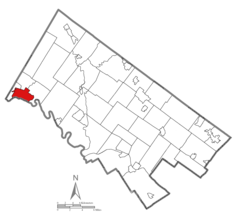|
Pottstown, Pennsylvania
Coin Club Medal
1969 Proof Medal 31mm (20.04 grams)
RUTTER-POTTS MANOR HOUSE BUILT BY THOMAS RUTTER BUILDER OF POOLE FORGE, FIRST IRON FORGE IN PA. 1716 1969, Poole Forge.
POTTSTOWN COIN CLUB ORGANIZED 1956 POTTSTOWN, PA., Wheat bundle.
You are bidding on the exact item pictured, provided with a Certificate of Authenticity and Lifetime Guarantee of Authenticity.
 Pottstown is a borough in Montgomery County, Pennsylvania, United States about 40 miles (64 km) northwest of Philadelphia and 20 miles (32 km) southeast of Reading, on the Schuylkill River. Pottstown was laid out in 1752-53 and named Pottsgrove in honor of its founder, John Potts. The old name was abandoned at the time of the incorporation as a borough in 1815. In 1888, the limits of the borough were considerably extended. Pottstown is the center of a productive farming and dairying region. Pottstown is a borough in Montgomery County, Pennsylvania, United States about 40 miles (64 km) northwest of Philadelphia and 20 miles (32 km) southeast of Reading, on the Schuylkill River. Pottstown was laid out in 1752-53 and named Pottsgrove in honor of its founder, John Potts. The old name was abandoned at the time of the incorporation as a borough in 1815. In 1888, the limits of the borough were considerably extended. Pottstown is the center of a productive farming and dairying region.
Pottstown’s iron and steel interests were once extensive. There were large rolling mills, furnaces, nail works, textile mills, bridge works, agricultural-implement works, boiler and machine shops, foundries, and manufactories of bricks, silks, shirts, hosiery, etc. In 1900, 13,696 people lived there; in 1910, 15,599; in 1920, 17,431; and in 1940, 20,194. The population was 22,377 at the 2010 census.
Modern-day Pottstown is on land originally deeded to William Penn. Germans, Swedes and English were among the area’s first European settlers. After establishment of the first iron forge in 1714, Pottstown’s fortunes became tied to the iron industry.
Eventually, blast furnaces for production of iron and later steel opened in the area. Iron and steel production attracted the Potts family, iron masters by trade. They established a forge and built a large home just west of the Manatawny Creek. John Potts founded a town in 1761 on part of the 995 acres (4.03 km2) that he owned. It is the home of the nation’s oldest mill, Pottstown Roller Mill.
Over time, Pottsgrove grew, and in 1815 it was incorporated under the name Pottstown, becoming the second borough in Pennsylvania, after Norristown.
The Philadelphia & Reading Railroad mainline reached Pottstown in 1838. The extension of the railroad to Mount Carbon in 1842 facilitated the movement of raw materials and finished goods that helped Pottstown’s economy grow. In a few years after the extension of the railroad, the population grew from 600 to 1,850. Pottstown’s metal production grew; steel from the borough was used in the Panama Canal and Golden Gate Bridge.
In 1944, the borough adopted a city manager form of government. By 1964, the borough saw the need to reorganize the municipal government. At the time, it had one of the largest borough councils in the state, with 20 members. This was reduced to seven members in redrawn wards.
The High Street Historic District, Old Pottstown Historic District, Pottsgrove Mansion, Grubb Mansion, Jefferson Elementary School, Pottstown Roller Mill, Reading Railroad Pottstown Station, and Henry Antes House are on the National Register of Historic Places.
Politics and government
Pottstown has a city manager form of government with a mayor and a seven-member borough council. The mayor is Stephanie A. Henrick and the manager is Justin Keller.
The borough is part of the Fourth Congressional District (represented by Rep. Madeleine Dean), the 26th and 146th State House District (represented by state Rep. Tim Hennessey state Rep. Joe Ciresi respectively) and the 24th State Senate District (represented by Sen. Bob Mensch).
Geography
Pottstown is located at 40°14′59″N 75°38′25″W (40.249690, -75.640262).
According to the United States Census Bureau, the borough has a total area of 4.9 square miles (13 km2), of which 4.8 square miles (12 km2) is land and 0.1 square miles (0.2 km2 or 1.83%) is water.
|





 Pottstown is a borough in Montgomery County, Pennsylvania, United States about 40 miles (64 km) northwest of Philadelphia and 20 miles (32 km) southeast of Reading, on the Schuylkill River. Pottstown was laid out in 1752-53 and named Pottsgrove in honor of its founder, John Potts. The old name was abandoned at the time of the incorporation as a borough in 1815. In 1888, the limits of the borough were considerably extended. Pottstown is the center of a productive farming and dairying region.
Pottstown is a borough in Montgomery County, Pennsylvania, United States about 40 miles (64 km) northwest of Philadelphia and 20 miles (32 km) southeast of Reading, on the Schuylkill River. Pottstown was laid out in 1752-53 and named Pottsgrove in honor of its founder, John Potts. The old name was abandoned at the time of the incorporation as a borough in 1815. In 1888, the limits of the borough were considerably extended. Pottstown is the center of a productive farming and dairying region. 




